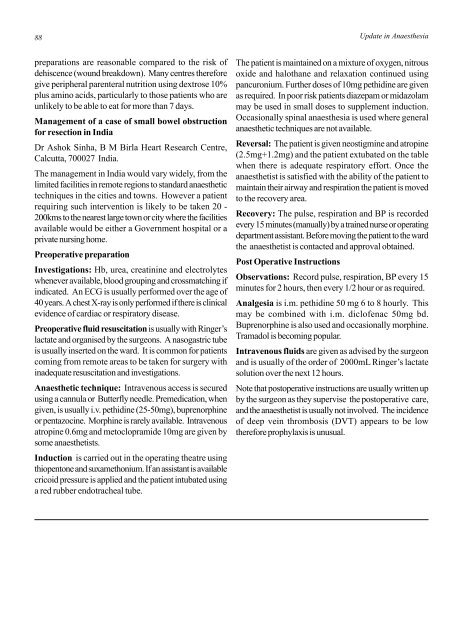Download Update 11 - Update in Anaesthesia - WFSA
Download Update 11 - Update in Anaesthesia - WFSA
Download Update 11 - Update in Anaesthesia - WFSA
Create successful ePaper yourself
Turn your PDF publications into a flip-book with our unique Google optimized e-Paper software.
88<strong>Update</strong> <strong>in</strong> <strong>Anaesthesia</strong>preparations are reasonable compared to the risk ofdehiscence (wound breakdown). Many centres thereforegive peripheral parenteral nutrition us<strong>in</strong>g dextrose 10%plus am<strong>in</strong>o acids, particularly to those patients who areunlikely to be able to eat for more than 7 days.Management of a case of small bowel obstructionfor resection <strong>in</strong> IndiaDr Ashok S<strong>in</strong>ha, B M Birla Heart Research Centre,Calcutta, 700027 India.The management <strong>in</strong> India would vary widely, from thelimited facilities <strong>in</strong> remote regions to standard anaesthetictechniques <strong>in</strong> the cities and towns. However a patientrequir<strong>in</strong>g such <strong>in</strong>tervention is likely to be taken 20 -200kms to the nearest large town or city where the facilitiesavailable would be either a Government hospital or aprivate nurs<strong>in</strong>g home.Preoperative preparationInvestigations: Hb, urea, creat<strong>in</strong><strong>in</strong>e and electrolyteswhenever available, blood group<strong>in</strong>g and crossmatch<strong>in</strong>g if<strong>in</strong>dicated. An ECG is usually performed over the age of40 years. A chest X-ray is only performed if there is cl<strong>in</strong>icalevidence of cardiac or respiratory disease.Preoperative fluid resuscitation is usually with R<strong>in</strong>ger’slactate and organised by the surgeons. A nasogastric tubeis usually <strong>in</strong>serted on the ward. It is common for patientscom<strong>in</strong>g from remote areas to be taken for surgery with<strong>in</strong>adequate resuscitation and <strong>in</strong>vestigations.Anaesthetic technique: Intravenous access is securedus<strong>in</strong>g a cannula or Butterfly needle. Premedication, whengiven, is usually i.v. pethid<strong>in</strong>e (25-50mg), buprenorph<strong>in</strong>eor pentazoc<strong>in</strong>e. Morph<strong>in</strong>e is rarely available. Intravenousatrop<strong>in</strong>e 0.6mg and metoclopramide 10mg are given bysome anaesthetists.Induction is carried out <strong>in</strong> the operat<strong>in</strong>g theatre us<strong>in</strong>gthiopentone and suxamethonium. If an assistant is availablecricoid pressure is applied and the patient <strong>in</strong>tubated us<strong>in</strong>ga red rubber endotracheal tube.The patient is ma<strong>in</strong>ta<strong>in</strong>ed on a mixture of oxygen, nitrousoxide and halothane and relaxation cont<strong>in</strong>ued us<strong>in</strong>gpancuronium. Further doses of 10mg pethid<strong>in</strong>e are givenas required. In poor risk patients diazepam or midazolammay be used <strong>in</strong> small doses to supplement <strong>in</strong>duction.Occasionally sp<strong>in</strong>al anaesthesia is used where generalanaesthetic techniques are not available.Reversal: The patient is given neostigm<strong>in</strong>e and atrop<strong>in</strong>e(2.5mg+1.2mg) and the patient extubated on the tablewhen there is adequate respiratory effort. Once theanaesthetist is satisfied with the ability of the patient toma<strong>in</strong>ta<strong>in</strong> their airway and respiration the patient is movedto the recovery area.Recovery: The pulse, respiration and BP is recordedevery 15 m<strong>in</strong>utes (manually) by a tra<strong>in</strong>ed nurse or operat<strong>in</strong>gdepartment assistant. Before mov<strong>in</strong>g the patient to the wardthe anaesthetist is contacted and approval obta<strong>in</strong>ed.Post Operative InstructionsObservations: Record pulse, respiration, BP every 15m<strong>in</strong>utes for 2 hours, then every 1/2 hour or as required.Analgesia is i.m. pethid<strong>in</strong>e 50 mg 6 to 8 hourly. Thismay be comb<strong>in</strong>ed with i.m. diclofenac 50mg bd.Buprenorph<strong>in</strong>e is also used and occasionally morph<strong>in</strong>e.Tramadol is becom<strong>in</strong>g popular.Intravenous fluids are given as advised by the surgeonand is usually of the order of 2000mL R<strong>in</strong>ger’s lactatesolution over the next 12 hours.Note that postoperative <strong>in</strong>structions are usually written upby the surgeon as they supervise the postoperative care,and the anaesthetist is usually not <strong>in</strong>volved. The <strong>in</strong>cidenceof deep ve<strong>in</strong> thrombosis (DVT) appears to be lowtherefore prophylaxis is unusual.
















